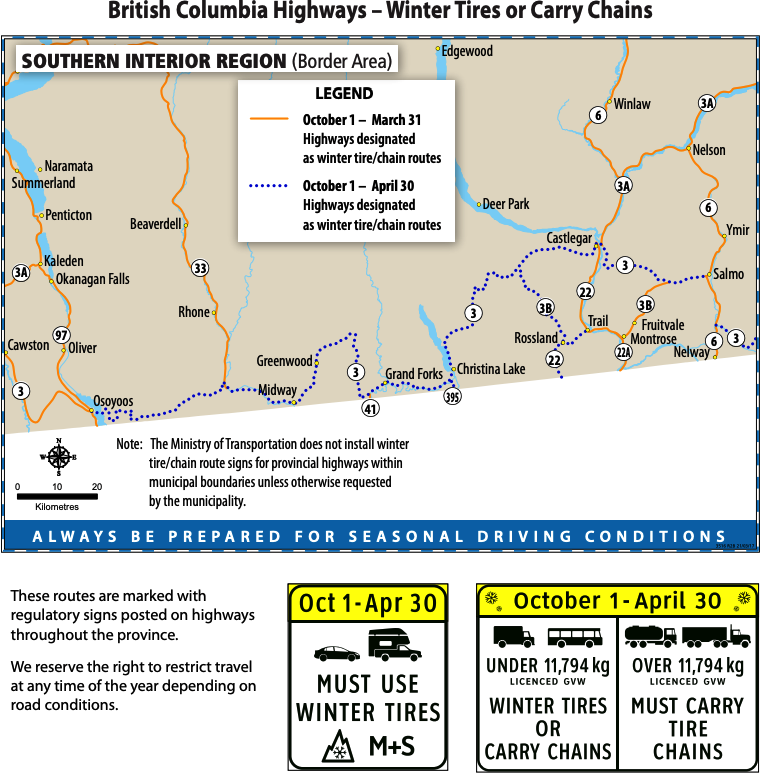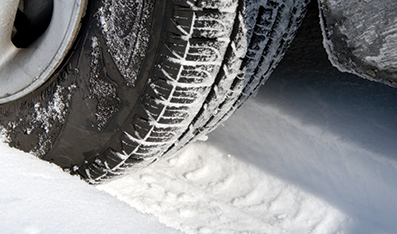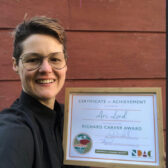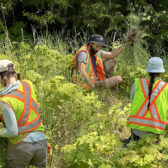Campaign reminds West Kootenay/Boundary drivers to Shift Into Winter
No matter what the weather is today, fall’s arrival signals the approach of B.C.’s most dangerous driving season.
The flip of the calendar page also brings the requirement for winter tires on most provincial highways starting on October 1.
The risk of crashing increases significantly in winter. The average number of casualty crashes due to driving too fast for the conditions more than doubles from fall to early winter, according to police statistics.
The 14th annual Shift into Winter campaign, supported by the Winter Driving Safety Alliance and managed by Road Safety at Work (RSAW), officially launches October 1. It aims to reduce the number of winter-related crashes, injuries, and deaths on B.C. roads.
“No matter how much experience you have, driving in snow, rain, fog, or icy conditions can be treacherous in Nelson and around the Central Kootenay region,” says campaign spokesperson Trace Acres, program director for RSAW.
Most crashes are preventable.
“The best way to help keep yourself and your passengers safe is to start preparing for winter now and plan ahead,” Acres says. “Waiting until the first storm hits is too late.”
Preparation includes installing winter tires, adjusting driver attitudes, and refreshing your memory about safe winter driving practices.
Winter tires are needed (and required by law)
B.C. law requires drivers to obey winter tire and chain signs throughout the province from October 1 to March 31. For select highways, including mountain passes and rural routes in high snowfall areas, the requirement extends until April 30.
Shift into Winter recommends using four matching tires displaying the three-peaked mountain/snowflake symbol with at least 3.5 mm of tread. They offer the best traction for faster stopping time and shorter stopping distance in cold temperatures, snow, rain, and on ice. Tires with the M+S (Mud and Snow) symbol also meet B.C.’s requirement.
A change in driver attitude is needed
Acres says drivers need to be pro-active when it comes to their safety – starting with a shift in their attitude.
“The majority of drivers are confident in their own abilities and are quick to blame other drivers as the reason why driving is a dangerous activity,” says Acres. Yet every driver can make an error, such as not turning on headlights during heavy rain or low light, that can cause a crash.
An RSAW survey in 2021 of people who drive for work found that only 38% of respondents believed driving above the posted speed limit is extremely dangerous when weather is foul. Yet driving too fast for conditions is one of the main contributing factors in vehicle crashes in B.C.
When weather is poor, only 36% of respondents acknowledged that driving with less than four seconds of following distance from the vehicle in front of them is extremely dangerous. Only 35% believed driving in snow or ice without winter tires, chains, or other traction devices is extremely perilous.
Finally, only 19% said it’s extremely dangerous to drive without winter tires, chains, or other traction devices when it’s not snowing or icy. Yet wet roads and poor visibility can be a lethal combination for drivers.
“Driving in winter conditions is a risk every single time you get behind the wheel,” says Acres. “We all need to understand that and do our part to improve our winter driving behaviours and practices.”
Safe winter driving practices are needed
Shift into Winter encourages drivers to follow these winter driving safety tips:
Prepare yourself
- Your winter driving skills are rusty at the beginning of the season and need practice. Google how to brake safely and get out of a skid. Remind yourself to not use cruise control, which can cause your vehicle to go into a skid in wet or slippery conditions.
Prepare your vehicle
- Give it a pre-winter maintenance check-up. Top up the anti-freeze and check tire pressure. Inspect brakes, wipers, lights, and engine belts. Keep an emergency kit in your vehicle.
Know before you go
- Check road and weather conditions on DriveBC.ca before heading out. Ask yourself if it’s safe for you to go. When road and weather conditions are poor, postpone your plans and avoid driving if possible. If you have to travel, select the safest route, give yourself extra time to get to your destination, and tell someone where you’re going and when you expect to arrive.
Slow down and increase your following distance
- Reduce speed to match conditions, and allow at least four seconds between you and the vehicle ahead. “Even the most experienced drivers can’t predict how their or the other drivers’ vehicle will handle in snow or on ice,” Acres says. Give yourself extra time and space to react.
Accelerate and brake slowly
On slick roads, start slowly and accelerate gradually to maintain traction and avoid spinning your wheels. When stopping, plan well in advance, apply the brakes gently, and slowly add pressure. Never brake suddenly.
Visit ShiftIntoWinter.ca for more information that can help reduce the risks when driving during winter.

BC’s winter tire law takes effect Saturday, October 1, 2022. Drivers can look at the above map to see the affected highways in their region. — Submitted

























